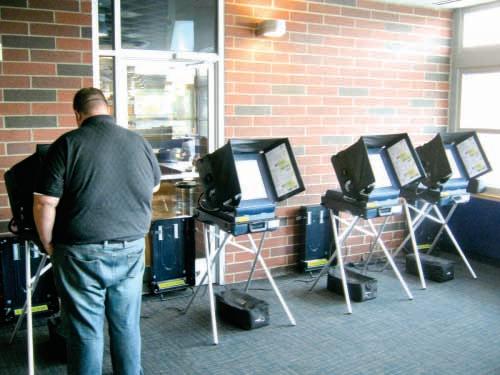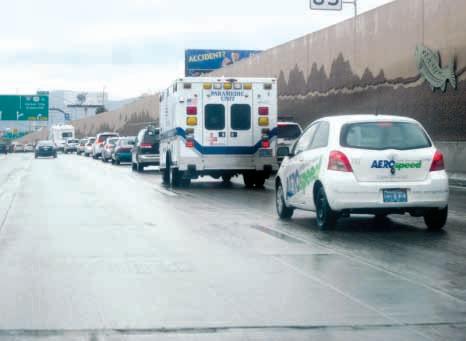
11 minute read
News
from June 4, 2015
Anti-gun sentiment unorganized
Gun control advocates may have missed a rare chance to organize in Nevada.
Advertisement
As reported in our cover story this week, the flurry of gun bills in the Nevada Legislature generated a lot of anti-gun activism in Washoe and Clark counties. But there seems to be little evidence that it will survive as an enduring movement or organization in the state.
A relatively new Nevada group, Nevadans for Background Checks, failed to exploit unhappiness over the guns-on-campus issue to establish an infrastructure for the future. “All they have is a website, no phone number or address,” said one Las Vegan who tried to contact the group. It had no lobbyist at the Nevada Legislature.
That was all the more surprising because the organization had legislation pending before the lawmakers. Last year, Nevadans for Background Checks collected 166,779 signatures to place a measure on the ballot to require background checks for all gun purchases, including online and gun shows. In Nevada, such petitions go first to the legislature, which can approve them, thus eliminating the need for a public vote. The background check measure was introduced as Initiative Petition 2. It was killed in a parliamentary maneuver on March 11 and so will appear on the 2016 ballot.
The death of guns-on-campus measures in the legislature spared the Nevada Board of Regents a decision on whether to disallow guns on campus in spite of a new state law. Court case law has held that administering state campuses is within the authority of the regents, not the legislature (“Empty chambers?” RN&R, April 9).
Rubio: Dump waste in Nevada
Republican presidential candidate Marco Rubio seems to have sided with South Carolina over Nevada on the issue of nuclear waste storage—at a time when there's increasing press attention on his need to win in Nevada.
South Carolina and Nevada are the second in line in the 2016 presidential nominating contests. South Carolina has the second primary election, after New Hampshire, and Nevada is the second caucus state, after Iowa. Both are likely to get heavy candidate and press attention.
South Carolina has been pushing for years for the opening of a nuclear waste dump at Nevada’s Yucca Mountain in Nye County, to give the Southern state a place to ditch 4,000 metric tons of radioactive waste from the state’s four commercial nuclear power plants and Savannah River Site.
Rubio, whose state of Florida has nuclear power plant wastes at three sites, has been a supporter of building a Yucca Mountain dump. Since his announcement of candidacy, he has made no effort to walk back that stance.
“Many Republican strategists see Rubio, a youthful Cuban-American who is among his party’s best communicators, as the candidate best positioned to reverse the tide in states like Nevada, where Democrats are looking to tighten their grip,” reported the Washington Post on May 28.
Rubio lived in Nevada as a child and his parents worked in tourism facilities. But he reportedly wants to derail Jeb Bush in South Carolina, a state carried by both of the George Bushes. That makes the Palmetto State more important to him than the Silver State.
However, the plot thickened this week when U.S. Sen. Lindsey Graham entered the race against Bush and Rubio. Graham’s home state is South Carolina. That may require Rubio to rethink his strategy, since Graham would have a home field advantage.
Graham has a long history of supporting a dump in Nevada. He said in 2004, “Outside experts and Congress have looked at this problem for years and we know Yucca Mountain, Nevada, is the appropriate location.”
But in more recent years, he has shifted his attention more to pushing for refunding the money the federal government has collected from nuclear power plant corporations to pay for the dump.
“Every utility involved in the process has put in billions of dollars into Yucca, so we should either use it or give the money back to the ratepayers,” Graham said in 2014.
—Dennis Myers
How Nevadans are represented by the candidates they elect could change, depending on how the U.S. Supreme Court comes out on a pending case.
How to count 101
Court case could alter redistricting practices
The U.S. Supreme Court has accepted a case that could have impact on Nevada— by though many are uncertain what that Dennis Myers impact will be. The case, Evenwel vs. Abbott, raises the question of whether voting districts should be apportioned according to their population or according to one portion of their population—eligible voters. Evenwel deals with local governing boards, but its outcome would likely eventually affect apportionment decisions for legislatures and Congress.
The case was brought by the Project on Fair Representation, a conservative D.C.-based organization that has won court victories that have reduced minority voting strength and challenged affirmative action.
Nevada’s founders required in the Nevada Constitution that both houses of the legislature be apportioned by population. In 1915, state lawmakers broke this law and created a system patterned after Congress that gave every county one senator (a “little federal” plan), thus malapportioning the Senate dramatically. In 1950,
Richard Pildes Election law expert
To read the U.S. Court of Appeals ruling being appealed to the Supreme court, visit www.tlc. state.tx.us/redist/ evenwelperry.pdf voters approved an amendment to the state constitution that made this illegal arrangement legal. As Nevada constitutional scholar Eleanore Bushnell put it, “the legislature had explicitly defied the constitutional provision” for 35 years of state history.
In 1960, the last census in which the little federal plan was used for legislative apportionment, the 84,743 residents of Washoe County were represented by one senator. The 568 residents of Storey County also got one senator. Malapportionment gave the 26 percent of Nevada’s residents who lived in 15 of the 17 counties 88 percent of the Senate (15). The 211,759 residents of Washoe and Clark counties had 12 percent of the senators (2).
Since then, the small counties have steadily shrunk as a percentage of state population. If the same system were in place today, that 88 percent of the Senate would represent just 5.8 percent of the state population. It has become difficult to create small county districts, though the size of the Assembly and Senate have been enlarged to about the size their halls can accommodate.
In its 1962 Baker vs. Carr and 1964 Reynolds vs. Sims rulings, the U.S. Supreme Court provided a remedy for this system that gave enormous power to regions with few residents. Baker found that legislative malapportionment was a proper subject for federal court review. Reynolds disallowed state senates patterned on the federal plan and said that districts must contain as close to the same number of people as possible. However, in devising formulas for districting, the court did not spell out which people were to be counted. Virtually all subsequent lower court rulings have used the general population, a practice that seemed to be sanctioned by the U.S. Supreme Court until the court accepted the Evenwel case.
If the court decides to use eligible voters as the base number in calculating apportionment, its meaning is anyone’s guess.
Lokken said it would have an “intense discriminatory” effect. “We count every man woman and child in formulating these matters,” he said. “Even if you’re not eligible to vote, that is your government.” He said basing districts on the adult population would be a form of voter suppression.
Cases like this have come to the Supreme Court before, but it has passed them over. Lokken said its acceptance of this one does not necessarily mean it intends to rule against using the general population.
Elections vs. campaigns
There is also speculation that a Supreme Court ruling in favor of using the adult population, more or less, as the basis for apportioning districts could shift influence from rural to urban areas—particularly in sunbelt states like Nevada. The New York Times quoted New York University constitutional law professor Richard Pildes that it “would be most significant in border states, like California, Texas, Arizona and Nevada, that have the largest proportions of noncitizens.”
Scholars believe illegal immigrants tend to live in urban areas, though there have been reports from immigration officials of numerous illegal residents working on Western ranches.
In an email exchange with the RN&R, Prof. Pildes said all humans are counted for the purpose of the census, numbers that are then used for congressional redistricting. Thus, non-voters nevertheless have an election impact because their numbers are reflected in districts—at least under the current practices. That could change if the court ruled against those practices.
“Non-citizens include legally resident aliens as well as resident aliens who lack legal authorization,” Pildes said. “None of these people vote or can vote, but they do get counted by the census. The Constitution directly requires that the census count include all ‘persons.’ Thus, the census count includes various categories of people who can’t vote, like those under 18. The Constitution also directly requires that the number of representatives in the U.S. House to which each state is entitled must be based on this census count. Thus, the number of representatives to which Nevada is entitled include all non-citizens who reside in the state—even though they do not have the right to vote. The best studies also conclude that a high percentage of even non-authorized alien residents do end up getting counted by the Census.”
That’s the election impact. However, the campaign impact, at least in Nevada, would probably be negligible.
That’s because Nevada has become so lopsidedly urban. The 15 small counties now account for less than 6 percent of the residents, and while that percentage can determine the outcome of a race—as in the Bush/Kerry election in 2004—the dynamics of campaign tactics and strategies would remain pretty much the same. The small counties tend to vote so rigidly conservative that Democratic candidates who invested much time in them often regretted it (“No sale,” RN&R, Aug. 28 2008), and likely would continue their focus on the urban areas. Because the small counties are regarded as safe for Republicans, they are not a big factor is campaign strategies.
Candidates would still cultivate the Latino vote, because their numbers in the state are substantial—about a fifth of the state electorate. That’s without considering illegal aliens, who aren’t really a campaign factor because they rarely vote. They avoid voter registration in order to stay off the radar of officialdom. As Dan Burk, then Washoe County voter registrar, said in 2012, “Does it really seem like a person would do that to cast a single vote … at the risk of getting kicked out of the country?”
To put it another way, illegal immigrants would be a factor in apportioning of districts but not in campaigns. Legal Latinos would be a factor in both—and a substantial one in Nevada.
The court’s ruling is not expected until next year. Ω

Fred Lokken Political analyst

Slow road

Freeway ramp closures, lane reductions and pavement repair work make the Spaghetti Bowl even more difficult to deal with than usual. Highway officials have urged drivers to leave for work earlier and to consider alternative routes.
THINK FREE.
FOr NEw rEAl EsTATE Or shATTEr IT FOr gOOD wITh

The Worlds Most Advanced Tattoo Removal Laser
6 TReATMenTs Less discoMfoRT feWeR sessions beTTeR ResuLTs 4-6 sessions, 6-8
Weeks ApART 4 TReATMenTs
10401 Double R blvD. • Reno, nv 775.322.3454 • nevaDaTaTTooRemoval.com
280945_4.75_x_5.5 4/7/15 11:00 AM Page 1
CALL NOW & SAVE UP TO 84% ON YOUR NEXT PRESCRIPTION
Drug Name Qty (pills) Price* Drug Name Qty (pills) Price*
Viagra 100mg 16 $ 99.99 Viagra 50mg 16 $ 79.99 Cialis 20mg 16 $ 99.99 Cialis 5mg 90 $129.99 Levitra 20mg 30 $109.99 Spiriva 18mcg 90 $169.99 Celebrex 200mg 90 $104.99 Advair 250/50mcg 180 ds $184.99 Zetia 10mg 100 $109.99 Crestor 20mg 100 $154.99 Combivent 18/103mcg 600 ds $119.99 Symbicort 160/4.5ug 360 ds $194.99 Cymbalta 60mg 100 $174.99 Namenda 10mg 84 $ 97.99 Nexium 40mg 90 $109.99 Diovan 160mg 100 $ 72.99 Aggrenox 200/25mg 200 $121.99 Entocort 3mg 100 $109.99 Propecia 1mg 100 $ 69.99 Januvia 100mg 90 $209.99 Quinine 300mg 100 $ 74.99 Ventolin 90mcg 600 ds $ 59.99 Pentasa 500mg 100 $109.99 Avodart 0.5mg 90 $ 99.99 Pradaxa 150mg 180 $459.99 Vagifem 10mcg 24 $ 94.99 Xarelto 20mg 84 $444.99 Asacol 800mg 300 $229.99 Tricor 145mg 90 $119.99 Colchicine 0.6mg 100 $ 89.99 Abilify 5mg 100 $139.99 Singulair 10mg 84 $ 33.99 Plavix 75mg 90 $ 26.99 Premarin 0.625mg 84 $ 75.99 Pristiq 50mg 100 $134.99 Janumet 50/1000mg 84 $184.99 Protonix 40mg 84 $ 29.99 Aciphex 20mg 100 $ 69.99 Evista 60mg 100 $134.99 Flovent 110mcg 360 ds $114.99 Niaspan 500mg 84 $ 84.99 Boniva 150mg 3 $ 49.99 Xifaxan 200mg 100 $139.99 Multaq 400mg 180 $574.99 Flomax 0.4mg 90 $ 49.99 Ranexa ER 1000mg 100 $114.99
All pricing in U.S. dollars and subject to change without notice. *Prices shown are for the equivalent generic drug if available. ✔ Over 1500 Medications Available ✔ Price Match Guarantee ✔ Call for Free Price Quote ✔ Prescriptions Required ✔ CIPA Certified
Toll Free Phone 1-800-267-2688
Toll Free Fax 1-800-563-3822 Shop: www.TotalCareMart.com or Call Now! 1-800-267-2688











